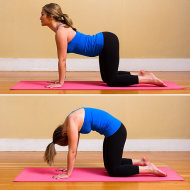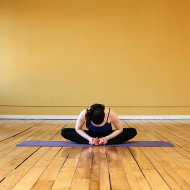Reclining Twist

You can do this spine-massaging stretch before you even get out of bed!
- Lie flat on your back. Draw both knees in toward your chest, and give them a squeeze.
- Release your legs, extend them straight up in the air as much as possible, and breathe in deep. You can also keep them bent close to your torso if this is easier.
- On the exhale, open your left arm, gaze to the left side, and drop your legs toward the right. Reach for your thigh, ankle, or foot, and look toward your open left hand.
- Hold for 30 seconds before coming back to center and then dropping your legs toward the left while gazing to your right. Hold for another 30 seconds, then come back to center and release back to lying position.
Behind-the-Back Stretch

Open up your chest and release neck tension with this simple stretch.
- Stand with your feet hip-distance apart and arms by your sides.
- Reach both hands behind your bum, and hold onto your left wrist with your right hand. Use your right hand to gently straighten your left arm and pull it away from you slightly.
- To increase the stretch in your neck, slowly lower your right ear toward your shoulder.
- Stay here for 30 seconds, and then switch sides.
-
 Tipover Tuck
Tipover Tuck
After your behind-the-back stretch, keep hands clasped behind your back and do the tipover tuck, which helps alleviate lower back pain, open your shoulders, and stretch your arms and hamstrings.
- Stand with your feet hips-width-distance apart. Interlace your hands behind your back. Keeping your legs straight, bend at the hips, tucking your chin and bringing your hands over your head.
- Relax the back of your neck, and if the stretch is too intense, then release your hands, placing them on the backs of your thighs, and soften your knees. Hold for 30 seconds, and slowly roll up to standing, then repeat.
Cat and Cow Pose

Moving between Cat and Cow poses helps warm up your entire body while giving your back a nice stretch.
- Begin with your hands and knees on the floor. Make sure your knees are under your hips and your wrists are under your shoulders. Begin in a neutral spine position, with your back flat and your abs engaged. Take a big, deep inhale.
- On the exhale, round your spine up toward the ceiling, and imagine you're pulling your belly button up toward your spine, keeping your abs engaged. Tuck your chin toward your chest, and let your neck release. This is your cat-like shape.
- On your inhale, arch your back, let your belly relax, and go loose. Lift your head and tailbone up toward the sky - without putting any unnecessary pressure on your neck. This is the Cow portion of the pose.
- Continue flowing back and forth from Cat Pose to Cow Pose, and connect your breath to each movement - inhale for Cow Pose and exhale on Cat Pose.
- Repeat for 30 seconds, rest or move into Child's Pose, and repeat again.
Butterfly

If you spend your days sitting at a desk, then take some time to open up your hip flexors with Butterfly.
- Sit on the ground, bending both knees and bringing your feet together.
- Using your hands, open your feet up like a book. Use your muscles to press your knees down toward the floor. This will help to open your hips even more.
- Lengthen your spine, drawing your belly button toward your spine. Relax your shoulders and gaze either in front of you or toward your feet.
- Stay here for about 30 seconds, and then slowly begin to fold forward, drawing your torso toward your legs. Remember to try to keep your spine straight.
- You can keep your hands on your feet, pressing your knees down with your arms. If you want more of a stretch, then extend your arms out in front of you instead. Stay here for 30 seconds or as long as you want.